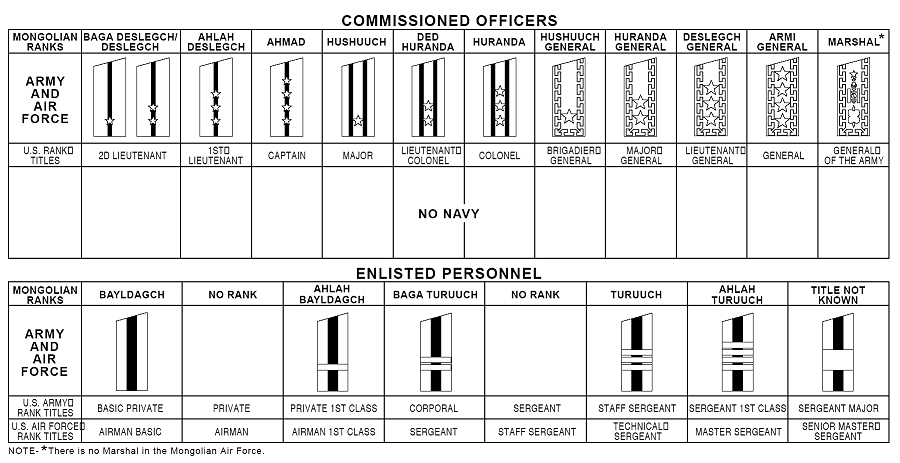| This Web book is based on public domain material provided by the US government and is available in several versions. See the editorial for more information. |

|

Home  National Security National Security  The Armed Forces The Armed Forces  Organization since 1968 Organization since 1968  Personnel Personnel |
||||
| See also: Beginning of Modern Military Practices, 1911-21 | ||||






|
||||
Personnel
The Universal Military Service Law declared all male citizens between the ages of eighteen and twenty-eight to be eligible for military conscription. Soldiers and noncommissioned officers (NCOs) in the Mongolian armed forces had been required to serve three years of active duty - two years, for those with higher education. In August 1988, compulsory military service for all conscripts was reduced to two years. Males seventeen or older who attended military schools were considered to be on active military duty. Those older than twenty-eight with special skills who had not been drafted might be accepted into special service. Male enlisted personnel could serve on active duty until the age of forty-five. Although there were women in the armed forces in 1989, no information was available on the role women played.
The uniforms and insignia of the armed forces in the 1980s were similar to those worn by the armed forces of the Soviet Union. Mongolian officer and enlisted uniforms differed in texture and quality of material, but the cut and style were the same. Women's uniforms generally were the same color and texture as their male counterparts' in the respective services and branches. There were four categories of uniforms in the army and the air force: full dress, dress, service, and field. The full-dress uniform was worn during formal reviews, such as parades; during conferral of a promotion in rank or a military decoration; or in performance of duties as a member of an honor guard. The dress uniform was worn during off-duty hours; the service uniform was worn for duty with troops in garrison. The field uniform was worn during training, maneuvers, and firing exercises. All four categories of uniform were olive drab. An ornate gold and red belt was worn on the service jacket of the full-dress uniform, along with medals, an olive drab shirt and tie, long trousers, low quarter shoes, and a service hat. The dress uniform was similar to the full-dress, except that service ribbons were substituted for medals and no belt was worn. The service uniform was the same as the dress uniform, except that leather Sam Browne-type belts were worn by officers, and garrison caps were worn by enlisted personnel. Both officers and enlisted personnel wore breeches, high boots, and steel helmets with their field uniforms. Seasonal differences allowed for the wearing of an overcoat, gloves, and a fur pile cap. A quilted olive drab jacket and field breeches also were worn as a winter field uniform. The background of the shoulder boards, the collar tabs, and the service hatband was red for the army and blue for the air force. All rank insignia were displayed on shoulder boards. Marshals (when there were any) and general officers wore stars on a broad, ornate gold stripe with a red background. Field-grade officers wore two longitudinal gold stripes and smaller gold stars, and company-grade officers wore one longitudinal gold stripe with even smaller gold stars. Enlisted ranks were identified by longitudinal or transverse gold stripes on shoulder boards. Branch-of-service insignias worn on collar tabs were gold metallic devices, except in the veterinary service, which used silver devices. Both officers and enlisted personnel wore a cockade on their headgear.
The armed forces maintained a reserve force in excess of 200,000 people. Enlisted personnel automatically were transferred to the reserves when they were discharged from active duty, and they remained in the reserves until the age of forty-five.
|
||||
Home  National Security National Security  The Armed Forces The Armed Forces  Organization since 1968 Organization since 1968  Personnel Personnel |
||||
Last Update: 2010-12-07


